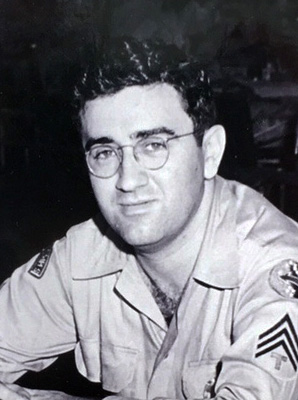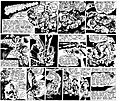Jerry Siegel facts for kids
Quick facts for kids Jerry Siegel |
|
|---|---|

Siegel during his service in the US Army in Hawaii, c. 1944
|
|
| Born | Jerome Siegel October 17, 1914 Cleveland, Ohio, U.S. |
| Died | January 28, 1996 (aged 81) Los Angeles, California, U.S. |
| Nationality | American |
| Area(s) | Writer |
| Pseudonym(s) | Joe Carter, Jerry Ess |
|
Notable works
|
Superman, Action Comics #1 |
| Awards | Inkpot Award, 1975 Will Eisner Comic Book Hall of Fame, 1992 Jack Kirby Hall of Fame, 1993 The Bill Finger Award For Excellence in Comic Book Writing, 2005 |
| Spouse(s) |
Bella Siegel
(m. 1939; div. 1948)Joanne Siegel
(m. 1948; |
| Children | 2 |
Jerome Siegel (October 17, 1914 – January 28, 1996) was an American writer. He is best known for co-creating Superman with Joe Shuster. Superman was the very first comic book superhero and became one of the most famous characters of the 20th century.
Jerry Siegel was recognized for his work in the comic book world. He was added to the Will Eisner Comic Book Hall of Fame in 1992. The next year, in 1993, he was also inducted into the Jack Kirby Hall of Fame.
Contents
Biography
Jerry Siegel's Early Life
Jerry Siegel was born on October 17, 1914, in Cleveland, Ohio. His parents were Jewish immigrants from Lithuania who came to the US in 1900. They changed their names to Michael and Sarah Siegel after moving to America. Jerry was the youngest of six children. His father owned a clothing store. Sadly, in 1932, Jerry's father died from a heart attack after being attacked by a shoplifter in his store.
In 1928, Jerry's family moved to a Jewish neighborhood called Glenville. He went to Glenville High School in Cleveland. Around age 16, he met Joe Shuster at school. Jerry said that when he and Joe met, "it was like the right chemicals coming together." They both loved science fiction, adventure stories, and movies.
Jerry graduated from high school in June 1934.
Creating Superman and Early Work for DC Comics
After high school, Jerry could not afford college. He worked different delivery jobs while trying to get publishers interested in his stories. In 1935, he and Joe Shuster started selling comic book stories to National Allied Publications. This company later became DC Comics.
Siegel and Shuster had been working on the Superman story and character since 1933. They hoped to sell it as a newspaper comic strip. But after many years of trying, they decided to publish Superman in a comic book instead. In March 1938, they sold all the rights to Superman to Detective Comics, Inc. (another company that became part of DC) for $130.
Siegel and Shuster later wished they hadn't sold Superman. He became incredibly popular and successful. DC Comics owned the character and earned a lot of money from him. However, DC Comics kept Siegel as the main writer and Shuster as the main artist for the Superman comics. They were paid well because readers loved their work. For example, in 1942, they earned over $63,000 together. Jerry bought a house and a car.
On June 28, 1943, Jerry was drafted into the United States Army. He was trained as an airplane engine mechanic and a film editor. He was sent to Honolulu, where he worked as a writer for the military newspaper Stars and Stripes. He mostly wrote funny articles. Jerry left the army on January 21, 1946.
Life After the War and Legal Battles
While Jerry was in the army in Hawaii, his friend Shuster told him that DC Comics had published a story about a child version of Superman called "Superboy." This story was based on an idea Jerry had given to DC Comics, but they had not bought it from him. Because DC Comics never bought the copyright for Superboy from Jerry, he sued them for the rights.
Jerry and Shuster also claimed that DC had not paid them enough money from the Superman radio show and merchandise. They also sued for the rights to Superman. After the trial, Siegel and Shuster agreed to give up the copyrights for both Superman and Superboy. In return, they received a payment of just over $94,000.
After the war, Jerry moved to New York. Between 1937 and 1947, while they were under contract, Siegel and Shuster earned more than $400,000 working for DC Comics.
After leaving DC Comics in late 1947, Siegel and Shuster created a funny superhero called Funnyman. But it was not successful. This was the last time they worked together. Jerry then took on different freelance writing jobs. He wrote for a newspaper strip called Tallulah and comic books like Lars of Mars and G.I. Joe. In 1951, he was hired as a comic-book editor by Ziff-Davis. However, their comics division closed less than a year later. Jerry struggled to find steady work and faced difficult times. By 1959, he and his family were living in a small apartment and had trouble paying their bills.
Returning to DC Comics and Later Challenges
Jerry Siegel returned to DC Comics in 1959 because his second wife encouraged him. Even though he wrote some Superman stories, he no longer had control over the creative decisions. He had to follow his editor's instructions. During this time, he wrote many stories about the superhero team called the Legion of Super-Heroes. He added many popular characters to this team. It's hard to know exactly what Jerry wrote during this time because DC Comics usually didn't list the creators' names. His last work for DC was a short story in Superman's Pal Jimmy Olsen #89 in December 1965.
DC Comics stopped giving him work in 1966. This happened when the company found out that Siegel and Shuster were planning another lawsuit to get back the copyright to Superman. Jerry lost that lawsuit.
After being let go again, Jerry faced financial problems once more. He could not find regular writing jobs. In 1975, when he heard that Warner Bros. was making a Superman movie, Jerry told the news reporters about his struggles. In response, Warner Bros. agreed to give Siegel and Shuster a payment of $20,000 a year for the rest of their lives. This amount was later increased to $30,000. In exchange, they agreed not to fight for ownership of the Superman copyright.
Characters Created by Jerry Siegel
During his first time working at DC Comics (1935-1943), Jerry Siegel created these characters:
- Henri Duval, a French adventurer.
- Doctor Occult, a detective who investigates strange, supernatural things.
- Radio Squad, a police story series.
- Spy, a series about a world-traveling investigator named Bart Regan and his helper Sally Norris.
- Superman, a costumed hero with amazing strength.
- Superboy, a younger version of Superman.
- The Spectre, a ghostly hero who seeks justice.
During his second time working at DC Comics (1959-1966), Jerry Siegel created these characters, many of whom were part of the Legion of Super-Heroes:
- Bouncing Boy, a hero who can turn into a bouncy ball.
- Brainiac 5, a super-smart hero.
- Cosmic King, a villain who can control cosmic energy.
- Duplicate Damsel, a hero who can make copies of herself.
- Invisible Kid, a hero who can turn invisible.
- Matter-Eater Lad, a hero who can eat anything.
- Lightning Lord, a villain who can control lightning.
- Phantom Girl, a hero who can become a ghost.
- Chameleon Boy, a hero who can change his shape.
- Saturn Queen, a villain with mind-control powers.
Work for Amalgamated Press
After leaving DC Comics, Jerry Siegel wrote for a British comic called Lion. He wrote stories for a character called The Spider. His stories were published from January 1966 to February 1969.
Personal Life
Jerry Siegel stayed involved in science fiction fandom even after he started working for DC. He went to Chicon, which was the second World Science Fiction Convention in 1940. He even dressed up as Clark Kent for the convention's costume party.
Jerry married Bella Lifshitz on June 10, 1939. She was a Jewish woman from his neighborhood. They had a son named Michael (born in 1944). Jerry and Bella divorced in 1948.
In November 1948, Jerry married Joanne Carter. They first met in January 1935 when Joanne worked as a model for his colleague Joe Shuster. She was the model for the character Lois Lane. They met again at a costume party in New York in April 1948. On March 1, 1951, Joanne gave birth to their daughter, Laura. The family lived on Long Island before moving to California in 1968. Jerry and Joanne stayed married until he passed away in 1996.
Death
Jerry Siegel died on January 28, 1996, from a heart attack. He had been sick with heart problems for several years and had undergone surgery. He is buried at Hollywood Forever Cemetery in Hollywood, California.
Awards and Honors
- Inkpot Award, 1975
- Will Eisner Comic Book Hall of Fame, 1992
- Jack Kirby Hall of Fame, 1993
- The Bill Finger Award For Excellence in Comic Book Writing, 2005 (given after his death)
- Kimberly Avenue in Cleveland was renamed "Jerry Siegel Lane" in 2009
Images for kids
-
The Superman, created by Jerry Siegel and Joe Shuster in 1933. This was an early version of the character who later became Superman.
See also
 In Spanish: Jerry Siegel para niños
In Spanish: Jerry Siegel para niños



